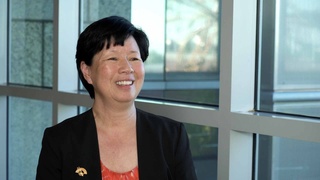Interviews
Coming back to America from Japan before the war
After I got back, I got to go to work again with my mother. And then the FBI come. They think I was hiding something, that was something else. I said, “Look for yourself.” I have nothing to hide, you know.
I was in Japan yeah. They thought I could be a spy or something. They looked little cellar and little house. In those days my mother used to make daikon no tsukemono in the big taru there. They used to tip that thing over. All that hard work there. I mean, they did everything that was wrong.
They thought we were hiding that thing or signaling. Look for yourself. Nothing like that. So they go under the basement, under the cellar and find barrel of daikon no tsukemono and that’s it. There’s nothing to hide.
Date: May 24, 2011
Location: California, US
Interviewer: John Esaki
Contributed by: Watase Media Arts Center, Japanese American National Museum
Explore More Videos

Going to camp with the Terminal Island people
(1927-2010) Political Activist


Interned at age fifteen, I saw camp as an adventure
(1927-2010) Political Activist

Incarceration, Deportation, and Lawyers
(1938-2020) Japanese American attorney and civil rights activist




Father’s Optimism
(b. 1934) Award-winning Disney animation artist who was incarcerated at Topaz during WWII

Tanforan Assembly Center
(b. 1934) Award-winning Disney animation artist who was incarcerated at Topaz during WWII

Father making shell brooches at Topaz
(b. 1934) Award-winning Disney animation artist who was incarcerated at Topaz during WWII

The Dopey bank that survived the war
(b. 1934) Award-winning Disney animation artist who was incarcerated at Topaz during WWII

Her brother’s reasons as a No-No Boy
(b. 1923) Japanese American poet, activist

Neighbor took care of her mother after grandfather was taken by FBI
Sansei judge on the Superior Court of Los Angeles County in California

Foreign language education was severely restricted during the war
Professor of Law, University of Sao Paulo, Lawyer, Translator (b. 1948)
